Opinion - Another day; another freshwater report. By now, you could recite this stuff in your sleep: too many cows pissing too much nitrate, drought by irrigation. Greedy farmers, shrill environmentalists. Equivocal scientists, euphemistic politicians.
All of them allow that we must do better. And, next day, we don't.

We must stop worshipping trout and the dollars they bring, Dave Hansford says. Photo: 123rf
The Ministry for the Environment's (MfE's) latest cardiogram on our rivers - Our Fresh Water 2017 - reveals that their pulse is stronger in a few places, weaker in many more than before. Nitrogen runoff is up, dissolved phosphorus loads are down. The waters of a quarter of monitored lakes are considered "poor to very poor".
Urban streams are, in the main, filthy.
Denial welled up like an eddy on the Buller.
From this latest damnation - this absolute cowpat of a report card - Federated Farmers somehow deduced that: "It's clear... that the quality of 80 percent of our waterways is improving..."
"The value of this report", opined Irrigation NZ CEO Andrew Curtis, "is that it gives us a 'starting point' to work from."
Pretty much, then, like the Christchurch earthquakes left us a "starting point" for the rebuild.
Sometimes, it seems like the only one not bullshitting us about water is nature.
Ninety per cent of all New Zealand's wetlands are now under friesians or concrete. Three-quarters of native freshwater fish are threatened with extinction. A third of aquatic invertebrates and plants are also circling the effluent drain.
That's not a starting point; that's practically an end game.

The Whanganui River. Photo: RNZ / Leigh McLachlan
The MfE report makes one thing crystal: bacterial contamination, nitrogen loads, sedimentation, are much worse in urban and pastoral reaches. All those indicators are much better in "native" land classes; forested tracts on conservation land.
In other words, we're the problem.
But we always knew that. You could dam the Waikato with the reports that have made it patently clear, yet still we do nothing, because one unthinkable, inviolate fate no political party will ever allow in New Zealand is the failure of agriculture, and that is the real starting point.
It explains why another 1235 hectares of Southland's wetlands vanished between 2007 and 2015.
It explains why Fish and Game and then Forest and Bird quit the Land and Water Forum in frustration after the National government all but ignored recommendations forged over years of multi-sector negotiation.
It explains why we now rate our rivers and lakes according to your chance of contracting a serious bacterial infection from them.
Yet endlessly comes the claim that we do not know enough, that more research is needed.
"Once we have a more complete data set and improved reporting, I have no doubt that the next report will show a truer picture of the impact our activities have on waterways...," Curtis assured.
Sure, the science is important, but we must not monitor our waterways to ruin. We know exactly what we have to do.
We have to stop doing the same things; concreting every square urban metre; allowing the grime of our industry, our transport, and our every action to stain the nearest creek - and expecting that freshwater will somehow cope.
We must stop worshipping trout and the dollars they bring, and respect instead the right of our native fish to endure.
We must stop fooling ourselves that this venal pursuit of untrammelled agricultural expansion and intensification will bring anything but the stagnation of the very waters that keep us alive.
Now that would be a start.
*Dave Hansford is a freelance science and environment writer and blogger.





